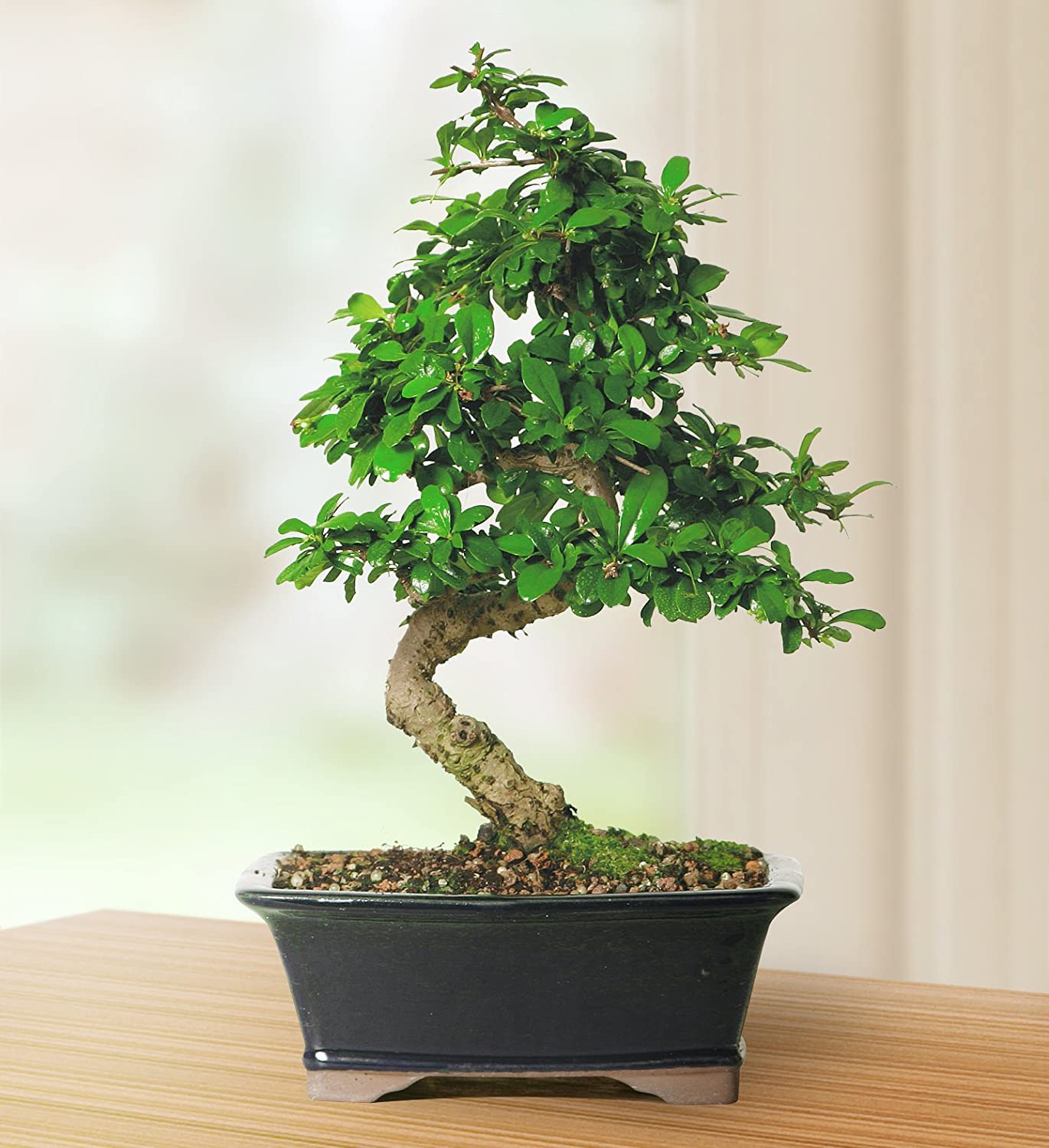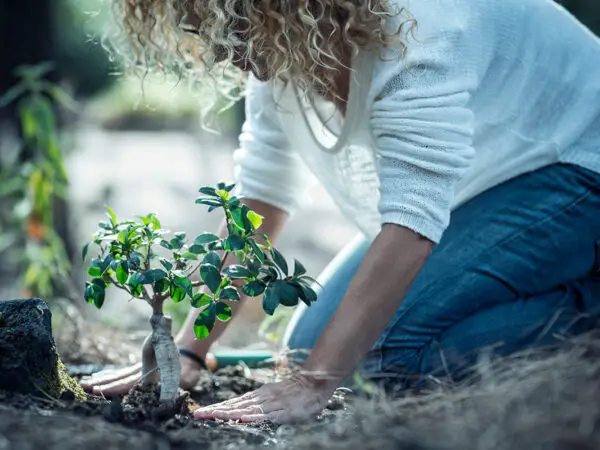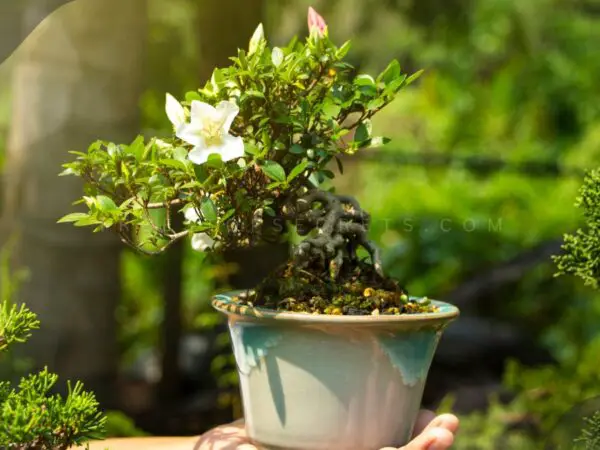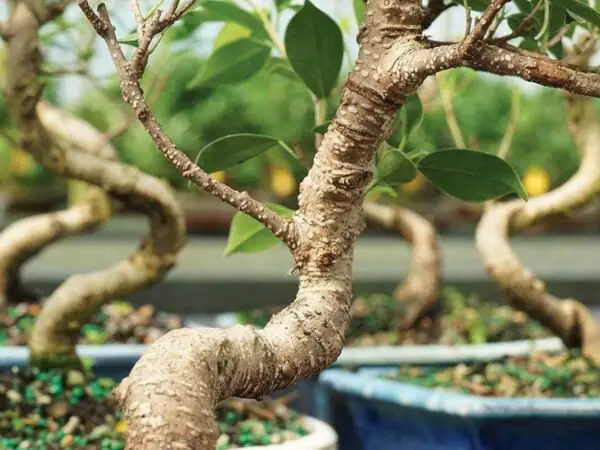If you're looking to bring a touch of nature indoors, bonsai trees are a perfect choice. Not only do they add a splash of green to your space, but they also bring a sense of tranquility and style. In this article, we’ll explore the 10 best bonsai trees for indoors that are both easy to care for and visually stunning.
Best Indoor Bonsai Trees
Indoor bonsai trees are miniature trees that are grown in containers and can thrive indoors. Unlike outdoor bonsai trees, these are specifically selected and trained to adapt to the indoor environment, requiring less sunlight and controlled humidity levels.
Indoor bonsai trees are perfect for those who want to enjoy the beauty and tranquility of bonsai without needing a garden. They are carefully pruned and shaped to mimic the appearance of mature, full-sized trees but are small enough to be kept indoors. Growing bonsai trees indoors requires an understanding of the unique needs of each tree species, such as light, water, humidity, and temperature.
Examples:
Here are some popular indoor bonsai trees:
-
Ficus Bonsai
- Description: The Ficus bonsai is one of the most popular indoor bonsai due to its resilience and low maintenance.
- Tips: Keep it in bright, indirect light and water moderately. The Ficus can tolerate low humidity and can recover quickly from overwatering.
-
Jade Bonsai (Crassula Ovata)
- Description: The Jade Bonsai is a succulent plant known for its thick, shiny leaves and low water requirements.
- Tips: Place it in a spot with plenty of sunlight. Water only when the soil is completely dry to prevent root rot.
-
Chinese Elm Bonsai
- Description: The Chinese Elm has small leaves and can adapt well to indoor conditions, making it an excellent choice for beginners.
- Tips: Needs a lot of light; place near a window. Maintain high humidity and regular watering.
-
- Description: While traditionally an outdoor bonsai, Juniper can be grown indoors with proper care.
- Tips: Requires plenty of light and good air circulation. Avoid overwatering; prefers slightly dry soil.
-
Serissa Bonsai (Tree of a Thousand Stars)
- Description: Known for its tiny white flowers and small leaves, the Serissa bonsai is perfect for indoors.
- Tips: Needs good lighting and regular watering. Sensitive to changes in environment, so keep in a stable location.
Choosing Indoor Trees
Selecting the right indoor bonsai is essential for creating a thriving environment. Understanding the factors that contribute to successful indoor growth and the types of bonsai that flourish in these conditions can help in making an informed decision.
Factors for Indoor Growth
When considering indoor bonsai, several key factors influence their growth and health:
| Factor | Description |
|---|---|
| Light Requirements | Indoor bonsai need bright light, ideally from a southeast or west-facing window. They may require supplemental lighting during darker months. |
| Temperature | Tropical and subtropical bonsai thrive in warm indoor conditions and cannot tolerate cold temperatures. |
| Humidity | Indoor environments can be dry, so maintaining adequate humidity is important for tropical bonsai. |
| Watering | Regular watering is crucial, as indoor bonsai can dry out faster than outdoor ones. The frequency depends on the species and the indoor climate. |
Tropical and subtropical bonsai are the best choices for indoor environments because they do not require a dormancy period in winter, unlike temperate species that need this phase for their growth cycle.
Types of Indoor Bonsai
The types of bonsai suitable for indoor cultivation primarily include tropical species. Here are some popular options:
| Bonsai Type | Characteristics |
|---|---|
| Ficus | Known for its resilience and adaptability, ideal for beginners. |
| Dwarf Jade | A succulent with thick leaves, it thrives in bright light. |
| Fukien Tea | Features glossy leaves and small white flowers, prefers warmth. |
| Hawaiian Umbrella | Unique umbrella-shaped leaves, loves humidity. |
| Sweet Plum | Produces small fruit, prefers bright indirect light. |
| Chinese Elm | Hardy and forgiving, it can tolerate variable conditions. |
| Japanese Maple | Beautiful foliage, requires more care to thrive indoors. |
| Pine Trees | Some varieties can adapt, but they need specific conditions. |
| Cedar Trees | Generally require outdoor conditions but can be adapted for indoor use with care. |
| Junipers | Can thrive indoors with sufficient light and care. |
All bonsai are naturally outdoor trees, but tropical species are the only exceptions that can be cultivated indoors due to their inability to withstand lower temperatures without artificial warmth. Successful indoor cultivation can be challenging, as many trees may not show signs of distress until 1-2 years after being placed indoors (Bonsai4me). Selecting species that can cope with indoor environments is crucial for success.
Top 10 Indoor Trees
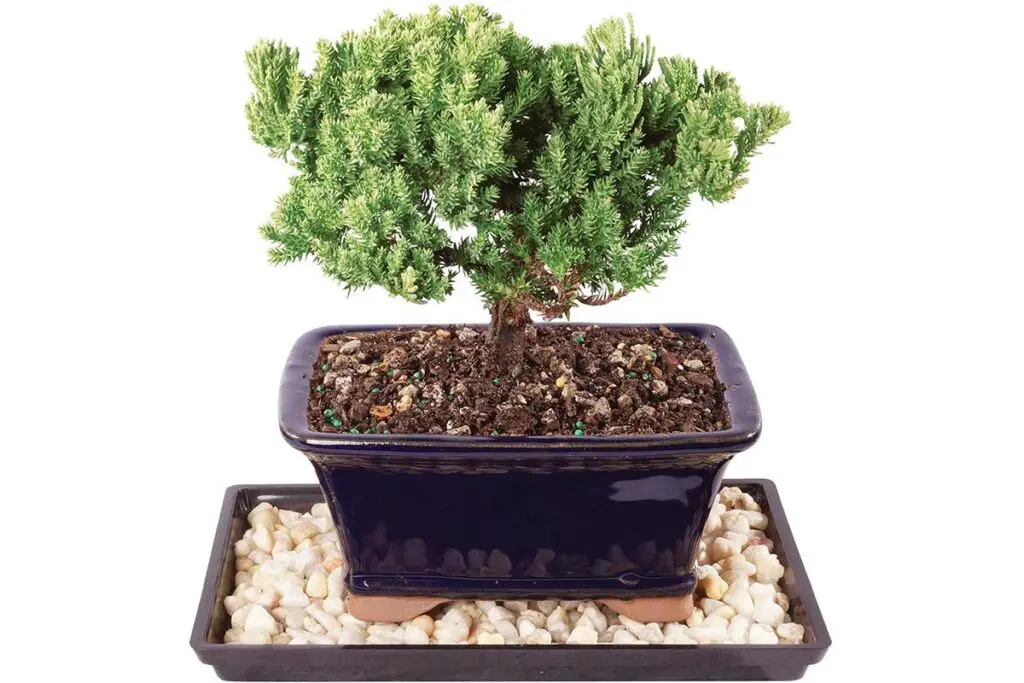
When I embarked on my bonsai journey, I discovered a variety of trees that thrive indoors. Here are my top 10 best bonsai trees for indoors, each offering unique beauty and care requirements.
Ficus Bonsai
The Ficus Bonsai is the most common and easiest to care for indoor bonsai tree. It is tolerant of low humidity and resilient, making it an excellent choice for beginners (Bonsai Empire). Its glossy leaves and adaptable nature allow it to thrive in various indoor conditions.
Dwarf Jade
Dwarf Jade, also known as Crassula, is another popular choice for indoor bonsai. This succulent has thick, fleshy leaves and a tree-like appearance. It requires minimal watering and does well in bright light, making it perfect for those who might forget to water frequently (Bonsai Empire).
Fukien Tea
Fukien Tea (Carmona) is admired for its small, glossy leaves and beautiful white flowers. It adapts well to indoor environments but requires consistent care. This tree thrives with regular watering and bright, indirect light.
Hawaiian Umbrella
The Hawaiian Umbrella (Schefflera) is known for its lush foliage and distinct umbrella-shaped leaves. This tree is adaptable and can tolerate low light conditions, making it suitable for various indoor settings. It prefers a bit more humidity, so consider misting it occasionally (Bonsai Empire).
Sweet Plum
Sweet Plum (Sageretia) is recognized for its small leaves and attractive bark. It can produce tiny white flowers and small fruits, adding to its charm. This tree enjoys bright light and regular watering to keep it healthy.
Chinese Elm
Chinese Elms, also known as lacebark elms, are a common choice for beginners. They are easy to cultivate indoors and outdoors, featuring a rounded shape and multicolored bark that exfoliates for aesthetic appeal.
Japanese Maple
Japanese Maples are known for their stunning foliage, with red-burgundy or green leaves that change color in the fall. These trees require frequent watering during the growing season and thrive in bright light (Thursd).
Pine Trees
Pine trees are preferred for bonsai due to their hardiness and trainability. Species like Japanese Black Pine, Mountain Pine, Scots Pine, and Japanese White Pine are particularly suitable for bonsai cultivation. They can handle a variety of styles and are quite resilient.
Cedar Trees
Cedar trees, with their rough bark and short needle clusters, are popular among bonsai enthusiasts. Species like the cedar of Lebanon, Cyprus cedar, Himalayan cedar, and Atlas cedar can be grown as bonsai. These trees require well-drained soil and enjoy bright light.
Junipers
Junipers are a great bonsai plant for indoors due to their miniature aesthetic and ability to tolerate severe trimming. They thrive in bright, sunny spots and the soil should be allowed to dry slightly before watering.
This selection of bonsai trees offers a range of options for indoor enthusiasts, each with their own unique characteristics and care needs.
Care Requirements
Caring for indoor bonsai trees involves understanding their specific needs, particularly in terms of light, watering, and humidity. These factors are crucial for the health and growth of my bonsai trees.
Light Needs
Indoor bonsai trees thrive on sufficient light. I place my tropical bonsai trees in a bright location, ideally in front of a south-facing window. This position maximizes natural light exposure. If natural light is insufficient, I supplement with artificial lighting. Here are some general light requirements:
| Tree Type | Light Requirement |
|---|---|
| Ficus Bonsai | Bright, indirect light |
| Dwarf Jade | Bright light, some direct |
| Fukien Tea | Bright, indirect light |
| Hawaiian Umbrella | Bright, indirect light |
| Sweet Plum | Bright light, some direct |
| Chinese Elm | Bright, indirect light |
| Japanese Maple | Bright, indirect light |
| Pine Trees | Moderate light |
| Cedar Trees | Moderate light |
| Junipers | Bright, indirect light |
Watering Tips
Watering is a vital aspect of bonsai care. I generally water my indoor bonsai trees every two to three days, but this may vary depending on the specific tree variety. Proper watering involves thoroughly soaking the soil until water runs out of the drainage holes. I also mist the foliage periodically, which helps maintain humidity but should not replace regular watering. Here are some important watering practices:
| Watering Practice | Description |
|---|---|
| Frequency | Every 2-3 days |
| Soaking | Ensure water drains from holes |
| Misting | Occasionally mist foliage |
Information from Brussel's Bonsai
Humidity Levels
Humidity is another critical factor for indoor bonsai trees. They require high humidity levels to thrive, which can be challenging in indoor environments, especially during winter when central heating is used. I use humidity trays or mist my trees regularly to maintain adequate humidity. Here are some methods to improve humidity:
| Humidity Method | Description |
|---|---|
| Humidity Trays | Place trees on trays filled with water |
| Misting | Regularly mist foliage |
| Grouping Trees | Keep trees together to create a humid microclimate |
Maintaining proper humidity levels is essential for the health of my bonsai trees, as dry air can negatively impact their growth and vitality.
Potting and Soil
Taking care of my bonsai trees involves understanding their potting and soil requirements. Proper potting and the right soil can significantly impact the health and growth of indoor bonsai.
Repotting Frequency
I find that repotting is crucial for the health of my bonsai trees. The best time for this is early spring or early autumn, as most trees begin to show new shoots during these seasons. Repotting should only be done when the bonsai is in a healthy condition to avoid weakening it.
The frequency of repotting varies depending on the species of the tree. Broadleaf and deciduous trees typically need more frequent repotting compared to conifers like pine and junipers. Here's a simple guideline for repotting intervals based on tree type:
| Tree Type | Repotting Frequency |
|---|---|
| Broadleaf Trees | Every 1-2 years |
| Deciduous Trees | Every 1-2 years |
| Conifers | Every 2-3 years |
It is important to avoid repotting conifers immediately after intensive styling processes or when their root systems may be disturbed. This care helps maintain the health of my bonsai.
Soil Types
The choice of soil is equally important for my bonsai trees. A good bonsai soil should retain moisture while allowing excess water to drain quickly. Generally, I prefer using a mix of inorganic materials for my bonsai soil. Here are some common types:
| Soil Type | Description | Notes |
|---|---|---|
| Akadama | Japanese baked clay, favored by bonsai masters | Breaks down within 1-2 years; needs replacement |
| Volcanic Lava Soil | Maintains root hairs undisturbed | Essential for healthy survival after repotting |
Using volcanic lava soil is particularly beneficial as it helps keep the root system intact during repotting. Each type of soil has its advantages, and I select based on the specific needs of my bonsai species. By following these guidelines for potting and soil, I ensure my indoor bonsai trees thrive beautifully.
Fertilizing Indoor Trees
Keeping my indoor bonsai trees healthy and vibrant involves proper fertilization. Understanding the best fertilizers and how to apply them is essential for their growth and well-being.
Best Fertilizers
For my indoor bonsai trees, I have found that slow-releasing organic fertilizers are highly effective, especially for more mature specimens. Additionally, water-soluble and time-released fertilizers can work well when used as directed. Here are some recommended options:
| Fertilizer Type | Description |
|---|---|
| Slow-Release Organic | Provides nutrients gradually over time. Ideal for mature bonsai. |
| Water-Soluble | Quick absorption; great for younger trees or during active growth. |
| Time-Released | Delivers a consistent supply of nutrients over an extended period. |
Source: Brussel's Bonsai
Application Tips
Applying fertilizer correctly is crucial for maximizing its benefits. Here are some tips I follow for effective fertilization:
- Frequency: Fertilize during the growing season, typically from spring to early autumn. I apply fertilizer every 4-6 weeks during this period.
- Dilution: For water-soluble fertilizers, I ensure to dilute them as directed on the label to avoid over-fertilization.
- Amount: I start with a smaller amount and adjust based on the response of my bonsai trees. Over time, I observe how they react to find the right balance.
- Even Distribution: When applying granular fertilizers, I evenly distribute the granules around the base of the tree, avoiding direct contact with the trunk.
- Watering: After fertilization, I water my bonsai thoroughly to help the nutrients penetrate the soil.
By following these guidelines, I help ensure that my indoor bonsai trees thrive and remain beautiful.
Common Issues
Caring for bonsai trees can be rewarding, but it also comes with its challenges. Understanding common issues such as pests, diseases, and maintenance practices is essential for keeping my indoor bonsai healthy and thriving.
Pests and Diseases
Bonsai trees, like any other plants, can be affected by insects and diseases. Regular inspection is crucial to catch any problems early. I often inspect my bonsai for common pests like aphids, spider mites, and scale insects. If I notice any signs of infestation, I take action promptly. A brisk spraying of the trunk and foliage can help keep the tree clean. Garden centers typically offer products for treatment if any issues arise.
| Common Pests | Symptoms | Treatment |
|---|---|---|
| Aphids | Sticky residue, distorted leaves | Insecticidal soap |
| Spider Mites | Fine webbing, yellowing leaves | Neem oil or miticides |
| Scale Insects | Hard bumps on stems or leaves | Scrape off and treat with oil |
Maintenance Practices
Maintaining the health of indoor bonsai trees requires attention to several factors, including light, humidity, and watering. Indoor bonsai trees can shed up to 20% of their foliage when acclimating to a new environment. To minimize stress, I ensure my trees are placed in sunny areas, ideally near windows facing southeast or west. If sunlight is insufficient, I use a grow light to supplement (Brussel's Bonsai).
Humidity is another critical factor. Indoor bonsai trees thrive in good humidity levels, which I maintain by using humidity trays or misting the trees. Central heating systems in homes can drastically reduce humidity levels, so I am mindful of this during winter months.
When it comes to watering, I generally water my bonsai every two to three days. However, the specific watering needs may vary depending on the tree variety. I ensure the soil is thoroughly soaked until water runs out of the drainage holes. Misting the foliage is also beneficial, but it should not replace proper watering.
By being aware of these common issues and adopting proactive maintenance practices, I can ensure the longevity and vitality of my indoor bonsai trees.
Final Thoughts: 10 Best Bonsai Trees for Indoors
Growing bonsai trees indoors is a rewarding and relaxing hobby that can also enhance your home decor. With a variety of species to choose from, there is a bonsai tree that can fit almost any indoor environment. Remember, the key to successful indoor bonsai is understanding the specific needs of your tree, providing the right light, humidity, and care. Start with one of the trees mentioned above, and you’ll be well on your way to creating a serene and beautiful indoor space.
FAQs about 10 Best Bonsai Trees for Indoors
Q: What are the best bonsai trees for beginners to grow indoors?
A: The best bonsai trees for beginners to grow indoors include the Ficus, Jade, and Chinese Elm. These trees are resilient, require less maintenance, and can adapt well to indoor environments, making them ideal for beginners.
Q: How often should I water my indoor bonsai tree?
A: The watering frequency for indoor bonsai trees depends on the species and indoor conditions. Generally, you should water when the top inch of soil feels dry. Overwatering can lead to root rot, so it's essential to check the soil moisture regularly.
Q: Can bonsai trees grow in low light conditions?
A: Some bonsai trees, like the Ficus, can tolerate lower light conditions, but most indoor bonsai trees require bright, indirect light. If your home has limited natural light, consider using artificial grow lights to provide adequate lighting.
Q: How do I maintain humidity levels for my indoor bonsai?
A: Indoor environments can be dry, especially with heating or air conditioning. To maintain humidity, place a humidity tray under your bonsai, mist the leaves regularly, or use a humidifier in the room. This helps replicate a more natural environment for your bonsai.
Q: What should I do if my indoor bonsai tree is losing leaves?
A: Leaf loss in indoor bonsai trees can result from various factors, such as overwatering, insufficient light, or environmental stress. Check the care requirements for your specific bonsai type, ensure it’s getting adequate light, adjust watering practices, and check for pests or diseases.
Q: Can I use regular potting soil for indoor bonsai trees?
A: Regular potting soil is usually too dense for bonsai trees and may retain too much water, leading to root rot. It's best to use a bonsai-specific soil mix that provides proper drainage and aeration, which are crucial for the health of bonsai trees.
Image Source: Paid image from CANVA

